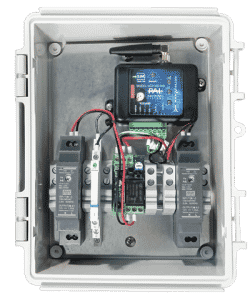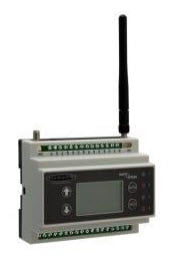- No products in the cart.

Advanced Systems 900mhz
Part #:80660S
The Advanced Stationary System is a 900 MHz radio frequency network with integrated I/O that can operate in most environments while eliminating the need for wiring runs. Wireless radio control systems are built around a Gateway, which acts as the wireless network master device, and one or more Nodes.
Demonstration Video
The Advanced Stationary System is an industrial wireless radio control I/O device with six discrete DIP switch selectable inputs, and six discrete (sourcing) outputs, with DIP switches for user configuration. The system combines Frequency Hopping Spread Spectrum (FHSS) technology and Time Division Multiple Access (TDMA) control architecture to ensure reliable data delivery within the unlicensed Industrial, Scientific, and Medical (ISM) bands. The transceivers provide two-way communication between the Gateway and Node, including fully acknowledged data transmission site survey analyses. Lost RF links are detected, and relevant outputs set to user-defined conditions.


The Advanced Stationary System provides reliable monitoring, without the burden of wiring or conduit installation, and can operate independently of, or in connection with, a PLC and/or PLC Software. Each wireless radio control system consists of one gateway and one or more nodes. The gateway device works as the master within each radio network system. The gateway initiates communication and reporting with the node. Each node can be connected to a sensor or output device and report back the state of the I/O to the master. The gateway and nodes can be arranged to extend the range (2 miles) of the network or to avoid obstacles in the transmissions path.
Includes:
- (1) Gateway P/N 80660G-001-001
- (1) Node P/N 80660N-001-001
- (2) Nema 4X Enclosures including 100-240 VAC universal power supply with 24 VDC output
- (2) Omni-Directional 6dB High Gain antennas with mounting brackets
- (2) Lighting/Surge arrestors
- (2) 25′ lengths of coaxial cable with “N” type connectors
- (4) 24 VDC class “C” relays rated at 6A @ 250 VAC
Power Requirements
- Supply Power: 12 VDC
- (15 W power supply included)
Advanced Stationary System Gateway Part #80660G
Advanced Stationary System Node Part #80660N
Discrete Input
- Input Rating: 3 mA max current at 30V dc
- Input Sample Rate: 62.5 milliseconds
- Input Report Rate: On Change of State
- 6 Dry Contact Inputs
Discrete Output
- 100 mA max current at 30V dc
- ON-State Saturation: Less than 3V at 100 mA OFF-state
- Leakage: Less than 10 μA
- Output Update Rate: 125 milliseconds
Relay Outputs
- 6 Class C Relays Rated 6A @ 250V
*The range of all radio products is dependent on local conditions and antenna selection/location.
Possible applications include:
- Wireless Pump Control
- Wireless Valve Actuation
- Wireless Conveyor Control
- Grain Augers
- Wireless Light Control
- Stackers
- PLC Activation
- Engine Control
- Wireless Automation
Advanced Stationary System
Part#:80222S
The Advanced Stationary System is a 900 MHz radio frequency network with integrated I/O that can operate in most environments while eliminating the need for wiring runs. Systems are built around a Gateway, which acts as the wireless network master device, and one or more Nodes.
The Wireless Automation System combines Frequency Hopping Spread Spectrum (FHSS) technology and Time Division Multiple Access (TDMA) control architecture to ensure reliable data delivery within the unlicensed Industrial, Scientific, and Medical (ISM) bands. The transceivers provide two-way communication between the Gateway and Node, including fully acknowledged data transmission site survey analyses. Lost RF links are detected, and relevant outputs set to user-defined conditions. Each device comes with two discrete inputs, two discrete (sourcing) outputs, two analog (0–20 mA) inputs, and two analog (0–20 mA) outputs.
The Wireless Automation System provides reliable monitoring, without the burden of wiring or conduit installation, and can operate independently of or in connection with a PLC and/or PLC Software. Each wireless system consists of one gateway and one or more nodes. The gateway device works as the master within each radio network system. The gateway initiates communication and reporting with the node. Each node can be connected to a sensor or output device and report back the state of the I/O to the master. The gateway and nodes can be arranged to extend the range (3 miles) of the network or to avoid obstacles in the transmissions path. The transceivers provide two-way communication between the gateway and node including fully acknowledged data transmissions.
Power Requirements
- Supply Power: 24 VDC
- (15 W power supply included)
- 100VAC-240VAC Input
Possible applications include:
- Wireless Pump Control
- Flow Rate Monitoring
- Conveyor Control
- Tank Level Monitoring
- Light Control
- Alarm Systems
- PLC Activation
- Data Logging
- Wireless Automation
Advanced Stationary System
Part#:80442S
The Advanced Stationary System is a 900 MHz radio frequency network with integrated I/O that can operate in most environments while eliminating the need for wiring runs. Systems are built around a Gateway, which acts as the wireless network master device, and one or more Nodes.
The Wireless Automation System combines Frequency Hopping Spread Spectrum (FHSS) technology and Time Division Multiple Access (TDMA) control architecture to ensure reliable data delivery within the unlicensed Industrial, Scientific, and Medical (ISM) bands. The transceivers provide two-way communication between the Gateway and Node, including fully acknowledged data transmission site survey analyses. Lost RF links are detected, and relevant outputs set to user-defined conditions. Each device comes with four discrete inputs, four discrete (sourcing) outputs, two analog (0–20 mA) inputs, and two analog (0–20 mA) outputs.
The Wireless Automation System provides reliable monitoring, without the burden of wiring or conduit installation, and can operate independently of or in connection with a PLC and/or PLC Software. Each wireless system consists of one gateway and one or more nodes. The gateway device works as the master within each radio network system. The gateway initiates communication and reporting with the node. Each node can be connected to a sensor or output device and report back the state of the I/O to the master. The gateway and nodes can be arranged to extend the range (4 miles) of the network or to avoid obstacles in the transmissions path. The transceivers provide two-way communication between the gateway and node including fully acknowledged data transmissions.
Power Requirements
- Supply Power: 24 VDC
- (15 W power supply included)
- 100VAC-240VAC Input
Possible applications include:
- Wireless Pump Control
- Flow Rate Monitoring
- Conveyor Control
- Tank Level Monitoring
- Light Control
- Alarm Systems
- PLC Activation
- Data Logging
- Wireless Automation
PalGate Wireless Cellular Controller
Part #:01270-001-001
This convenient remote one-output discrete switch is
controlled by a simple cell phone application or desktop
software.
The PAL Cellular Switch is operated through an intuitive cloud-based software that gives flexibility to use it from a desktop or through the dedicated PAL application.
Manage the PAL device from a single dashboard, view unlimited event logs, and manage user access.
The discrete output can be used to activate/deactivate larger contactors or act as an external control signal for logic devices such as Smart Relays or PLCs. It can also be used as a dry contact input for other RF (radio frequency) transmitters and/or transceivers.

Advanced Cellular Controller
This versatile industrial wireless controller allows for cellular as well as local ISM band (900MHz) communication and Ethernet connectivity.
Features:
- Cellular communications via Verizon LTE (4G)
- Ethernet connectivity
- (4) Universal Inputs; (2) Discrete Outputs / (2) Analog Outputs
- MicroSD card for data logging
- Email and text alerts
- LCD display for I/O information
Cellular module is available for LTE (4G). The unit is also compatible with RCT’s Advanced Switch Systems (900MHz) and can act as either a standard Gateway radio (for use with remote Node radios) or as a Multi-Mesh Master radio (for use with remote Repeater radios). The controller is mounted in a NEMA-4X enclosure with 12VDC power supply, I/O terminal blocks and SPDT relays (if required).
For cellular modules, a small rubber duck style antenna is provided standard; additional external antennas are available depending on signal strength and local cellular coverage. Customers will be required to set-up monthly cell plans with their local provider. Email and text alerts can be configured for notification of I/O status and alarm states. Remote activation/deactivation of outputs is possible via text commands. Manual I/O status is available via text communication as well.



